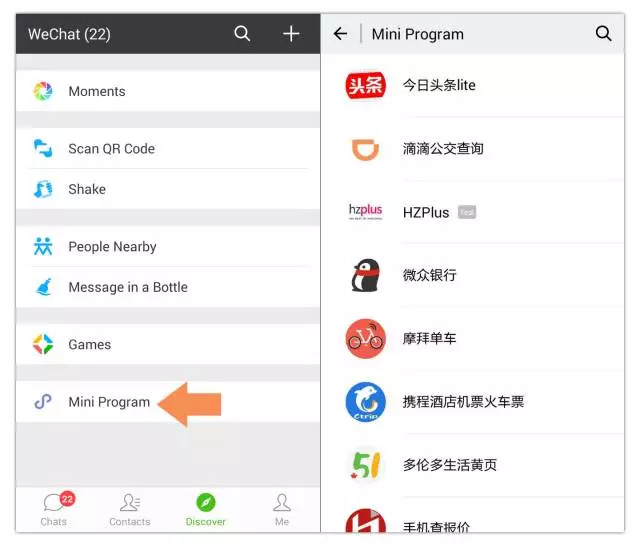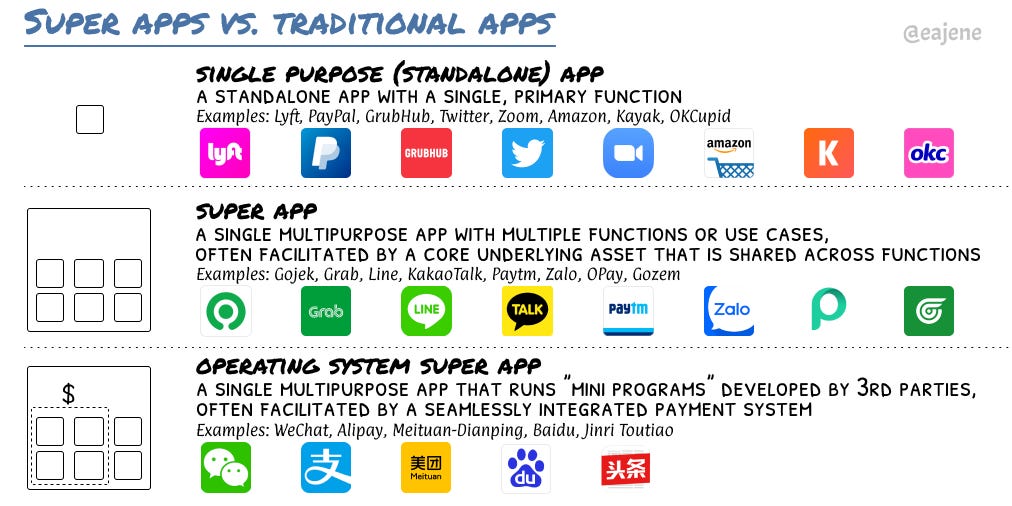Afridigest provides ideas & analysis for startup founders, operators, and investors across Africa and beyond. This post is the first part of a series exploring super apps in emerging markets. If you like this post, tap the heart icon here, share it, and let me know by replying here or via Twitter: @eajene. Subscribe to get this post and others like it delivered straight to your inbox.

Illustration by Alex Castro
Do it now: the birth of a behemoth
In 1996, in Guangzhou, China, Xiaolong ‘Allen’ Zhang released the beta version of a desktop email client called Foxmail. Over the next several years, Foxmail would win acclaim for its fresh, minimal aesthetic and user-friendly interface. By 2001, it enjoyed 33% market share in China with over 3 million users daily, besting Netscape and others, while its English version found favor among users in over 20 countries.¹ Four years later, newly-public Tencent came calling. Tencent, the internet conglomerate that had listed on the Hong Kong Stock Exchange in 2004, acquired Foxmail, China’s largest email client at the time, in March 2005—its first acquisition.²
As part of the purchase agreement, Zhang joined Tencent, where he was named General Manager of its Guangzhou R&D division. His primary task? Strengthen its webmail product, QQ Mail.³ By 2008, QQ Mail was praised by users for its simplicity and ease of use, and it became China’s largest email service provider. Tencent now enjoyed a dominant position in webmail (via QQ Mail) and in desktop email (via Foxmail).
Two years later in October 2010, inspired by the launch of Kik Messenger, which gained 1 million users in its first 15 days, Zhang developed a vision of China’s mobile internet future. He fired off a long email to his boss, Tencent CEO Huateng ‘Pony’ Ma, explaining the upcoming threats and opportunities as he saw them. And he proposed that his Guangzhou R&D division develop a smartphone-based communications tool for the future he envisioned. Ma simply replied with four Chinese characters: 马上就做, or in English: “Do it now.”⁴
By November 2010, the project was launched. The team, none of whom had significant experience in mobile app development, was comprised of 10 people: 2 iOS developers, 3 Android, 1 Symbian, 1 UI, 2 focused on the backend, and Zhang himself.⁴ Two months later on Jan 21, 2011, they launched a bare-bones, text-driven messaging app. Appropriately, they called it Weixin (微信), which roughly translates to 'micro-message’ in English.

Its reception, however, was muted. Unlike the instant runaway success that Kik enjoyed, user registrations for Weixin were far and few between. With growth still only trickling in in the coming months, Zhang's team felt strong pressure from internal Tencent teams to shut down the project. After all, Tencent already offered a communications tool, QQ Instant Messenger, that boasted millions of users, so why continue building a redundant and failing product?
Despite that logic, Zhang persisted. On May 10, he & his team released Weixin 2.0 with a new feature, voice messaging; soon after, user acquisition began to accelerate. On August 3, 2011, Weixin 2.5 was released, with an update that allowed users to view and communicate with people nearby, making Weixin a tool not only for chatting with friends & family but with strangers as well. This feature struck a chord with users and Weixin experienced explosive growth for the first time.
Two months later, on October 1st, Weixin 3.0 was released with another new feature, 'Shake.' When users shook their phones in a specific way, they’d be connected to others on the Weixin network who had shaken their phones at the same time. This Shake functionality was the first of its kind in the market, a veritable Weixin innovation, and it proved extremely viral, raising Weixin’s growth trajectory to new levels.
Weixin 3.5 launched in December 2011 with QR code functionality that allowed for online-offline interactions, but the next release which significantly boosted Weixin’s growth trajectory anew was version 4.0. Launched on April 19, 2012, (after the app had reached 100 million registered users,) Weixin 4.0 introduced ‘Moments,’ a feature which brought social networking functionality to the app.⁵ Moreover, Weixin 4.0 marked the launch of an English version app for the international market; it was called WeChat.⁶
WeChat’s evolution to super app
After having reached roughly 200 million monthly active users, Weixin/WeChat (hereinafter WeChat) launched version 5.0 in August 2013. It included social gaming features (a strong revenue driver today) and mobile payment functions, the humble beginnings of today’s WeChat Pay.⁷
In January 2014, after Tencent invested $45 million in Chinese ride-hailing company, Didi, WeChat partnered with the transportation company to allow users to hail rides and pay for them via WeChat Pay.⁷ This partnership, which continues today, solidified WeChat’s super app status, as it became a powerhouse for a diverse and varied suite of services: chat/communications, payments, social networking, gaming, and transport.
In May 2014, WeChat added another major service vertical: commerce. With the launch of WeChat Stores, any business, regardless of size, could open a branded store in the app and enjoy payment services provided by WeChat Pay.⁸ And in January 2017, WeChat launched “mini programs,” an ecosystem of lightweight apps developed by third parties that run within WeChat.⁹ Today, there are millions of these mini-apps, providing users with a nearly unlimited variety of services and almost infinite utility.

WeChat has come a long way since Xiaolong ‘Allen’ Zhang sent the email that set things in motion. It’s no longer a simple messaging application; instead, it’s become a quasi-operating system, uniquely embedded into the daily lives of its users.
“Unlike the rest of the world, in China the most important layer of the smartphone stack is not the phone’s operating system. Rather, it is WeChat.
…Every aspect of a typical Chinese person’s life, not just online but also off is conducted through [this] single app.
There is nothing in any other country that is comparable, particularly the Facebook properties (Facebook, Messenger, and WhatsApp) to which WeChat is commonly compared. All of those are about communication or wasting time: WeChat is that, but it is also for reading news, for hailing taxis, for paying for lunch (try and pay with cash for lunch, and you’ll look like a luddite), for accessing government resources, for business. For all intents and purposes WeChat is your phone, and to a far greater extent in China than anywhere else, your phone is everything.”
— Ben Thompson, Stratechery.
WeChat, which pioneered the concept of ‘mini-programs’ or apps-within-an-app, is the original super app as the term is used today. From almost being shuttered after the lackluster reception of its first release, to becoming the globally recognized internet behemoth of today, WeChat has had a storied history. Now with 1.2 billion monthly active users, it offers ample convenience and nearly unlimited choice; the vast majority of its users can meet all of their online needs without ever leaving the app. In doing so it created a playbook that many aspirants endeavor to replicate, and, directly or indirectly, it’s inspired a new generation across Asia, Africa, and elsewhere to employ this model.
As for Zhang himself, he’s remained at Tencent, now one of the world’s ten most valuable companies, where today he is a Senior Executive Vice President leading the Weixin/WeChat business unit. Across China, where he is revered as ‘the Father of WeChat,’ he has attained Steve Jobsian status; he continues to evangelize and employ the minimalistic design principles of Dieter Rams that he has held dear since he launched Foxmail.
Defining 'super app'
While WeChat was one of the first to embody the concept of the super app, it didn’t pioneer the term. Rather, in February 2010, just a few months before Zhang sent his famed email, Blackberry Founder & then-CEO, Mike Lazaridis introduced the concept of smartphone ‘super apps’ in his keynote speech at Mobile World Congress in Barcelona.
Although his meaning doesn’t fully align with how the term is used today, there are some common threads.
"We think these applications are so compelling that we don't just call them apps, we call them super apps. Super apps are integrated with other apps, giving you a seamless experience across the device...Super apps are applications that once you start using them, you'll wonder just how you lived without them...the last thing you want to do is to have to check a dozen different applications separately…
This is what we mean when we talk about super apps: creating experiences that are so seamless to use, that are so well integrated with the core applications that they become a natural part of your daily interactions.”
— Mike Lazaridis, Blackberry Founder, MWC 2010 Keynote Speech.
This early seeding of the term ‘super app’ as shorthand for compelling, seamlessly integrated everyday experiences on a smartphone continues to bear fruit today.
For Connie Chan, a General Partner at Andreessen Horowitz, “A super app is something that mixes and mashes a bunch of seemingly unrelated services together in one application.” Whereas for Ming Maa, President of Grab, a Southeast Asian super app, it’s “a platform that really enables an entire ecosystem or economy of digital services.” Similarly, Gojek, the Southeast Asian super app that helped popularize the term, takes the marketing position that “A super app is many apps within an umbrella app. It’s an operating system that unbundles the tyranny of apps. It’s a portal to the internet for a mobile-first generation.”
But these definitions, while acceptable, are unsatisfying. Certainly, not every app that aggregates various services together warrants the term super app.
Sidu Ponnappa, Gojek’s SVP of Engineering & former MD of Gojek India agrees.
“Whenever I see a lot of hype around super apps … the question there becomes: what is it that you are increasing the efficiency of? Otherwise it’s just traditional diversification… There needs to be some common asset that you’re increasing the efficiency & experience for, [then] using that to diversify. A super app is a platform play where the underlying, core shared asset is not a software product asset in a traditional sense, it’s something less obvious like, in our case, our fleet.”
— Sidu Ponnappa, Use Case Podcast.
This requirement of a shared, core business asset is a subtle but powerful addition. It has a great deal of utility as a framework from which to evaluate the potential of various providers to become true super apps. So, then, this leads to the following definition:
A super app is a digital platform that leverages one or more core business assets across multiple use cases (i.e. service verticals) in order to increase efficiency and/or user experience.
At this juncture, it’s worth noting two things: first, while the most common super app core assets have been payment or fleet assets, other possibilities exist, including identity assets, traffic/distribution assets, and data assets; secondly, there are also operating system super apps, so to speak. These meet the super app definition above but they also offer a ‘mini program’ ecosystem that incentivizes third parties to develop mini-apps.

Why super apps work best in emerging markets
Given WeChat’s tremendous success, it’s not surprising that the app serves as inspiration for a wide variety of companies. However, not everyone agrees that the model makes sense. Tinder’s ex-Chief Product Officer, Brian Norgard, is apparently one such detractor.
And Sheji Ho, an experienced Asia e-commerce analyst, writes “deep down, fundamental user behavior isn’t much different across cultures or markets. Regardless of origin, users want to find information easily and quickly, want websites and apps to load quickly, look for social proof, etc.” He adds, “If you think Chinese users enjoy going ten layers deep into an app to consume a certain service then you’re too naive. This is all done so companies can make more money by paying less for customer acquisition.”
While there are certainly financial reasons why businesses pursue the super app model, proponents largely point to the convenience & various benefits super apps offer to users. For one, in regions where the cost of data is high, downloading and using a single super app may be preferable to the cost involved in downloading multiple single-purpose apps separately.
Moreover, in some markets, most users can generally only afford lower-end smartphones with limited storage; in these scenarios, super apps can be extremely valuable, offering the utility of thousands of apps with the storage cost of just one. In addition, when a single app is used, users eliminate the time, effort and learning curve necessary to create individual accounts and transact across different apps, a process that may be daunting for new smartphone users. Finally, under Ponnappa’s framework, super apps, by definition, increase efficiency or user experience by intentionally leveraging one of a business’ competitive advantages.
It seems to be the case, then, that super apps may enjoy a distinct advantage in markets with the following characteristics: cost-conscious consumers with low but growing purchasing power, high relative costs of internet data, relatively recent adoption of smartphones, and ‘mobile-first’ leapfrogging of the PC era.

These characteristics are prevalent across emerging markets. It is thus no surprise that savvy operators are introducing super app models far and wide in these regions.
From Gozem in Francophone West Africa, to PiPay in Cambodia, to Rappi in Latin America, to Opay in Nigeria, to Zalo in Vietnam, a new generation of super apps are taking lessons from WeChat and its early successors to create and capture value in a novel way.
If you liked this and want me to write more like it, hit the “like” button at the bottom, or share this! This simple act will train me to do a better job for you. Thanks!
RECOMMENDED READING
RECOMMENDED LISTENING
RECOMMENDED WATCHING
from Hacker News https://ift.tt/2ywedA1
No comments:
Post a Comment
Note: Only a member of this blog may post a comment.